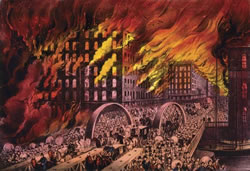
Chicago Fire
At around 9 p.m. on Sunday, October 8, 1871, Patrick and Catherine O’Leary’s barn on DeKoven Street, not far from downtown Chicago, burst into flames. A mixture of strong winds, an unseasonably dry year and a large amount of wooden structures and homes would be the fuel for the firestorm that would become the Great Chicago Fire of 1871. When the tragedy had passed, 2000 acres had been consumed by fire with the loss of 17,500 buildings and a death toll between two and three hundred.
It was reported by Daniel Sullivan, reporter for the Chicago Tribune, that the fire was started when Mrs. O’Leary’s cow accidentally kicked a lantern onto the hay covered floor of the O’Leary barn.
That is the story as we know it but here’s another theory!
On the night of the Great Chicago Fire, large fires also broke out in Peshtigo, Wisconsin, Port Huron, Michigan, parts of Minnesota and Ontario. In Peshtigo witnesses said that the fire started in the woods outside of the town. Due to the dry conditions the fire spread very quickly. When it was finally contained, the fire had burned twelve cities and towns in a 1.5 million acre area. The Port Huron fire burned nearly 1.2 million acres of land. These two fires together took the lives of over 2500 people in a four day time period. Witnesses in a seven state area within and around the firestorm ravaged area reported seeing balls of fire in the sky just after dark on October 8th.
Shortly after the Great Midwest Fires of 1871, Minnesota Congressman, Ignatius Donnelly wrote a book called “Ragnarok”, which is the Old Norse translation of Fate of the Gods. Congressman Donnelly suggested that the fires were started by Biela’s Comet that was first discovered in 1821 and made an appearance every six years and nine months until 1866. It was set to reappear in 1872 but has not been seen again. An article written in The Athenaeum, the newsletter for the Boston Athenaeum membership library, dated August 8, 1885 stated that Biela’s Comet was seen as a double comet along side of Denning’s Comet in 1852, however Biela’s Comet “underwent violet perturbation through near approach to the earth in 1872.” Meaning that on its way back toward earth for its 1872 appearance it experienced some form of breakup that would have appeared to witnesses in the Midwest as a meteor shower.
A more modern view of this possibility proposed by Physicist Robert Wood states that if Biela’s Comet had come into contact with an asteroid field and broke apart, then the rock and debris could have started fires all over the Midwest. This would explain how such large fires in Wisconsin, Michigan, Illinois, Minnesota and Ontario could have started simultaneously on the night of October 8, 1871.
